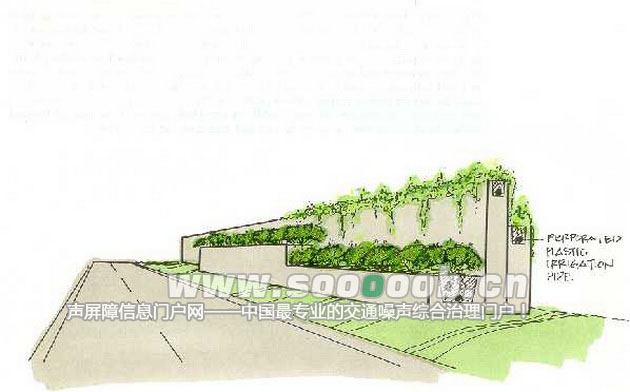
Noise barrier walls can be softened through the use of plants that camouflage their hard edges (eg cap, base, and ends).隔音屏障的墙壁可以软化通过使用植物伪装他们的硬边(如帽,基地,并结束)。 Vines cascading over the top of walls and base plantings can be used effectively as softeners.藤过的墙壁和基地种植顶部的级联,可以有效地加以利用,作为软化剂。
The scale of barrier walls can be reduced by using plants to break up the expanse of wall surfaces and to reduce the relative height of the wall.隔离墙的规模,可以减少使用植物打破了大片墙面,墙,以减少相对高度。 Mature overstory trees are tall relative to a 15' barrier wall.成熟的林冠树木高大相对15'围墙。 Planting overstory trees in front or behind a wall can effectively reduce the apparent wall height.林冠树木种植在前面或后面墙上,可以有效地减少明显的墙的高度。 Shrubs and vines can be used to break up the expanse of the wall body.可以用灌木和藤本,打破了无垠的墙体。
Visual direction can be added through the use of plantings that accentuate horizontal or vertical lines.可以添加通过使用水平或垂直线的播种面积,突出视觉方向。 Creeping vines and low spreading ground covers emphasize horizontally while pyramidal, conical and columnar plants provide vertical elements, drawing the eye upward.爬藤蔓和低蔓延的地面覆盖强调水平,而金字塔形,圆锥形和柱状植物提供了垂直的元素,绘制眼睛向上。
Plants can be used to create points of focal interest or accent.植物可以用来创建焦距利益或口音点。 Plantings that provide contrast in color, form and/or size will be visually prominent.将显眼的种植面积,提供颜色,形式和/或大小的对比。 Accent plantings can provide aesthetic stimulation for motorists.口音种植面积,可以为驾驶者提供的审美刺激。 They may also be used to subtly direct views and provide locational cues.他们也可能被用来巧妙地直接意见,并提供地点的线索。
Plants can be strategically placed to frame views and objects.植物可放置帧的意见和对象。
编辑:声屏障信息门户网 翻译:谷歌网
